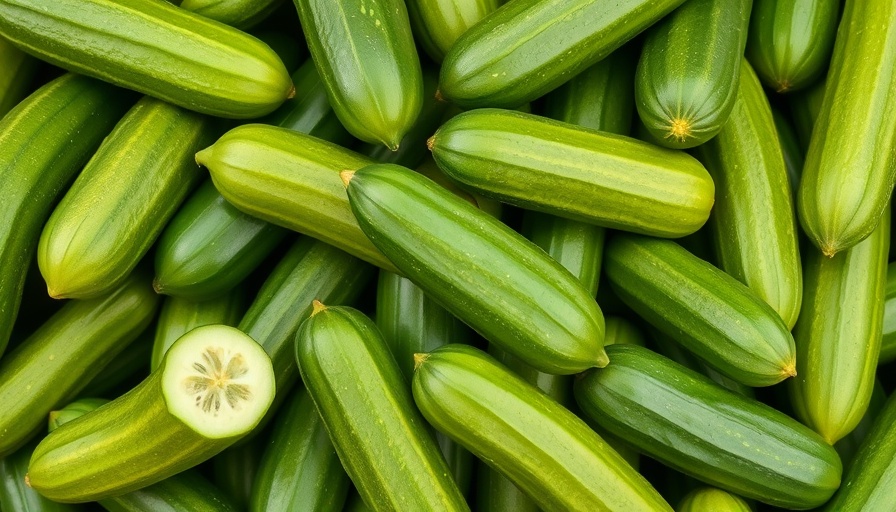
Exploring the World of Cucumber Plants: A Gardener's Guide
Cucumbers, botanically known as Cucumis sativus, are a beloved vegetable that can transform both our gardens and our tables. Whether you're a seasoned gardener or a novice excited to plant your first seeds, understanding the different types of cucumber plants can enhance your gardening experience. In this guide, we'll dive into various categories of cucumber plants, helping you determine which types suit your growing conditions and culinary needs best.
Understanding Slicing and Pickling Cucumbers
One of the first distinctions you’ll make when exploring cucumber varieties is between slicing and pickling types. Slicing cucumbers are what many people envision—these are typically larger, with a thick, dark green skin that can sometimes have a bitter taste. However, they’re perfect for fresh salads or snacking delightfully with dips. Usually, these cucumbers grow to about 7-10 inches long and can yield a bountiful crop when nurtured properly.
On the flip side, pickling cucumbers are shorter, usually harvested between 3-5 inches, and have a thicker skin that crisps up beautifully during the pickling process. Their rich flavor and smaller seeds make them equally enjoyable to eat fresh. For gardeners, this versatility means you can enjoy the same variety in different ways, boosting both your harvest and flavor experiences.
The Importance of Pollination in Cucumber Growth
Another vital aspect of cucumber cultivation revolves around their flowering and pollination patterns. Cucumber plants can fall into two categories based on their reproductive biology: monoecious and gynoecious. Monoecious cucumbers carry both male and female flowers on the same plant, while gynoecious varieties primarily produce female flowers. This differentiation is essential because it can influence your garden's overall yield.
Understanding these pollination needs can significantly optimize your harvest. For instance, while monoecious plants rely on insects for pollination, gynoecious ones may or may not require these helpers. Selecting the right types according to your garden’s pollinator activity can lead to fruitful vines year after year.
Bush vs. Vining Cucumbers: Which Should You Choose?
Another consideration in your cucumber-growing journey is whether to plant bush or vining cucumbers. Bush cucumbers are characterized by their compact size, making them ideal for smaller gardens or container gardening. They tend to be more manageable, requiring less space and less support as they do not sprawl out like their vining counterparts.
Vining cucumbers, however, can be trained to grow vertically, saving ground space and potentially providing greater yields. These plants can reach impressive heights and often produce more fruit, but they will require trellises or supports, adding another layer of consideration to your garden design.
Exploring Specialty Cucumbers: The Unique Options
While traditional varieties often get the spotlight, don’t overlook specialty cucumbers, which come in a range of interesting shapes, sizes, and colors. Examples include the delightful Armenian cucumber, recognized for its unusual appearance and sweet taste, or the delightful cucumber known as ‘Lemon,’ which resembles a small lemon and is often celebrated for its uniqueness. These varieties can add visual appeal to your garden and excitement to your culinary endeavors!
The Hybrids vs. Heirlooms Debate
When selecting your cucumber plants, you'll also encounter the hybrid versus heirloom debate. Hybrids are bred for traits such as disease resistance and higher yields, making them popular in commercial production. However, heirloom varieties, passed down through generations, tend to offer richer flavors and unique characteristics. Knowing your preferences and gardening goals can help guide you toward the right choice for your space.
Final Thoughts: Make Your Cucumber Choices Wisely
In conclusion, when considering which types of cucumber plants to grow, take into account the various categories including slicing and pickling varieties, pollination requirements, growth habits, specialty options, and the hybrids versus heirlooms dilemma. Armed with this knowledge, you’re well on your way to successfully cultivating a thriving cucumber garden!
As you embark on your vegetable gardening journey, don’t overlook the broader context of gardening tips that contribute to a successful crop. Sustainable gardening practices, understanding garden pests control, utilizing organic gardening techniques, and practicing effective garden maintenance can profoundly affect your gardening outcomes. Dive into gardening projects or create an inviting backyard landscape, where cuddly cucumbers reign supreme alongside vibrant flowers and lush greens.
 Add Row
Add Row  Add
Add 




Write A Comment